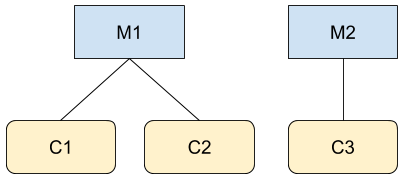Puedes obtener una lista de los clientes a los que puedes acceder con el método
ListAccessibleCustomers
en CustomerService. Sin embargo, es necesario entender qué clientes se muestran con este tipo de solicitud.
Obtener una lista de clientes a los que puedes acceder es una de las pocas solicitudes de la API de Google Ads que no requiere que especifiques un ID de cliente en la solicitud, y la solicitud ignora cualquier login-customer-id proporcionado.
La lista de clientes que obtengas se basará en tus credenciales de OAuth. La solicitud devuelve una lista de todas las cuentas en las que puedes tomar medidas directamente según tus credenciales actuales. Esto no necesariamente incluirá todas las cuentas dentro de la jerarquía de la cuenta, sino que solo incluirá las cuentas en las que se agregó al usuario autenticado con derechos de administrador o de otro tipo en la cuenta.

Imagina que eres el usuario A, que es administrador de M1 y C3 en las dos
jerarquías que se muestran en la figura. Si realizaras una llamada a la API de Google Ads, por ejemplo, a GoogleAdsService, podrías acceder a la información de las cuentas M1, C1, C2 y C3. Sin embargo, una llamada a CustomerService.ListAccessibleCustomers devolvería solo M1 y C3, ya que esas son las únicas cuentas en las que el usuario A tiene acceso directo.
En este ejemplo de código, se muestra el uso del
método
CustomerService.ListAccessibleCustomers:
Java
private void runExample(GoogleAdsClient client) { // Optional: Change credentials to use a different refresh token, to retrieve customers // available for a specific user. // // UserCredentials credentials = // UserCredentials.newBuilder() // .setClientId("INSERT_OAUTH_CLIENT_ID") // .setClientSecret("INSERT_OAUTH_CLIENT_SECRET") // .setRefreshToken("INSERT_REFRESH_TOKEN") // .build(); // // client = client.toBuilder().setCredentials(credentials).build(); try (CustomerServiceClient customerService = client.getLatestVersion().createCustomerServiceClient()) { ListAccessibleCustomersResponse response = customerService.listAccessibleCustomers( ListAccessibleCustomersRequest.newBuilder().build()); System.out.printf("Total results: %d%n", response.getResourceNamesCount()); for (String customerResourceName : response.getResourceNamesList()) { System.out.printf("Customer resource name: %s%n", customerResourceName); } } }
C#
public void Run(GoogleAdsClient client) { // Get the CustomerService. CustomerServiceClient customerService = client.GetService(Services.V22.CustomerService); try { // Retrieve the list of customer resources. string[] customerResourceNames = customerService.ListAccessibleCustomers(); // Display the result. foreach (string customerResourceName in customerResourceNames) { Console.WriteLine( $"Found customer with resource name = '{customerResourceName}'."); } } catch (GoogleAdsException e) { Console.WriteLine("Failure:"); Console.WriteLine($"Message: {e.Message}"); Console.WriteLine($"Failure: {e.Failure}"); Console.WriteLine($"Request ID: {e.RequestId}"); throw; } }
PHP
public static function runExample(GoogleAdsClient $googleAdsClient) { $customerServiceClient = $googleAdsClient->getCustomerServiceClient(); // Issues a request for listing all accessible customers. $accessibleCustomers = $customerServiceClient->listAccessibleCustomers(new ListAccessibleCustomersRequest()); print 'Total results: ' . count($accessibleCustomers->getResourceNames()) . PHP_EOL; // Iterates over all accessible customers' resource names and prints them. foreach ($accessibleCustomers->getResourceNames() as $resourceName) { /** @var string $resourceName */ printf("Customer resource name: '%s'%s", $resourceName, PHP_EOL); } }
Python
def main(client: GoogleAdsClient) -> None: customer_service: CustomerServiceClient = client.get_service( "CustomerService" ) accessible_customers: ListAccessibleCustomersResponse = ( customer_service.list_accessible_customers() ) result_total: int = len(accessible_customers.resource_names) print(f"Total results: {result_total}") resource_names: List[str] = accessible_customers.resource_names for resource_name in resource_names: # resource_name is implicitly str print(f'Customer resource name: "{resource_name}"')
Ruby
def list_accessible_customers() # GoogleAdsClient will read a config file from # ENV['HOME']/google_ads_config.rb when called without parameters client = Google::Ads::GoogleAds::GoogleAdsClient.new accessible_customers = client.service.customer.list_accessible_customers().resource_names accessible_customers.each do |resource_name| puts "Customer resource name: #{resource_name}" end end
Perl
sub list_accessible_customers { my ($api_client) = @_; my $list_accessible_customers_response = $api_client->CustomerService()->list_accessible_customers(); printf "Total results: %d.\n", scalar @{$list_accessible_customers_response->{resourceNames}}; foreach my $resource_name (@{$list_accessible_customers_response->{resourceNames}}) { printf "Customer resource name: '%s'.\n", $resource_name; } return 1; }
curl
# Returns the resource names of customers directly accessible by the user # authenticating the call. # # Variables: # API_VERSION, # DEVELOPER_TOKEN, # OAUTH2_ACCESS_TOKEN: # See https://developers.google.com/google-ads/api/rest/auth#request_headers # for details. # curl -f --request GET \ "https://googleads.googleapis.com/v${API_VERSION}/customers:listAccessibleCustomers" \ --header "Content-Type: application/json" \ --header "developer-token: ${DEVELOPER_TOKEN}" \ --header "Authorization: Bearer ${OAUTH2_ACCESS_TOKEN}" \
Cómo mostrar las cuentas canceladas
La API de Google Ads no proporciona una forma directa de enumerar las cuentas canceladas en una cuenta de administrador. Sin embargo, puedes usar la siguiente solución alternativa para recuperar esta lista.
Recupera la lista de vínculos de
ACTIVEcon el recursocustomer_client_linky crea una lista de clientes con el campocustomer_client_link.client_customer.SELECT customer_client_link.client_customer, customer_client_link.status FROM customer_client_link WHERE customer_client_link.status = ACTIVERecupera la lista de cuentas de
ENABLEDcon el recursocustomer_client.SELECT customer_client.id, customer_client.descriptive_name FROM customer_clientLa diferencia entre las dos listas te proporciona la lista de cuentas canceladas.

